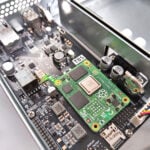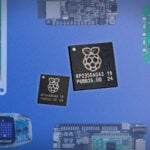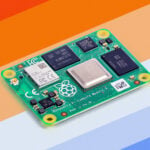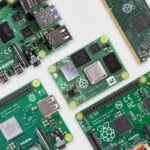Raspberry Pi Radio Module 2 available now at $4
Every Raspberry Pi computer since Raspberry Pi 3B+ has been a “module” from a conformance perspective: because we isolate the radio frequency components under a shield can, you can build your own wireless-enabled product around ours without having to re-certify the radio, saving tens of thousands of dollars.
Today we’re building on that heritage with our first standalone Wi-Fi and Bluetooth radio module. Priced at just $4, Raspberry Pi Radio Module 2 packages the same Infineon CYW43439 radio used on Raspberry Pi Pico W and Pico 2 W, and is an ideal choice for RP2040– and RP2350-based products that require turnkey wireless connectivity.

Cost-effective, easy-to-integrate radio connectivity
As our RP2040 and RP2350 customers go to scale, they often ask us for a wireless solution which provides software and feature-set compatibility with Raspberry Pi Pico-series devices.
We designed Radio Module 2 with these customers in mind. It features castellated edge pads and an on-board 2.4GHz antenna for ease of design and assembly, and a low-pin-count SPI host interface which makes efficient use of the host CPU’s I/O budget. Its compact 16.5mm × 14.5mm form factor and minimal external component requirements (just a host CPU and power) drive down mass-production costs. And, like all our recent Raspberry Pi computers, Radio Module 2 comes with full modular certification, making it an ideal choice for designers who wish to avoid the tricky and expensive radio certification process.

Raspberry Pi Pico SDK and MicroPython provide a proven, supported software stack, and a straightforward development experience, from prototyping with Pico W or Pico 2 W to production with Radio Module 2.
Excellent single-antenna Wi-Fi and Bluetooth performance
Radio Module 2 offers 1×1 single-band 2.4GHz Wi-Fi® 4 (802.11n) and Bluetooth® 5.2, supporting both Bluetooth Classic and Bluetooth Low Energy. Its integrated internal PA, LNA, and T/R switch deliver excellent wireless performance even when sharing a single antenna between Wi-Fi and Bluetooth.

You can find technical details of Radio Module 2 in its comprehensive datasheet. It has already seen the light of day in a number of partner products, including SparkFun’s Thing Plus – RP2350, and Pimoroni’s Pico Plus 2 W, and we’re looking forward to playing spot-the-RM2 in the next wave of connected devices.






27 comments
Jump to the comment form
Pawan Bakhtiani
Can’t we just use ESP32 module?
Gabriel
yes, you can. But I believe that this would be basically an “Plug and play” (PnP) solution for their microcontrollers. their hardware/software documentation and support is always strong and adding it to a project would be easier because of their strong availability as well.
Raspberry Pi Staff Eben Upton — post author
Exactly that! We’re trying to make it easier for people to migrate from Pico prototyping to RP2xxx production, without having to completely retool the wireless networking support.
crumble
You pay not with money when you use ESP32. They have a lot of issues with multicore and memory.
If you need the computing power Espressif provide, you are lost. There will be no stable version of your system. OK a little hard, but I had problems for many years until I lost interest in wasting my spare time.
On paper ESP32 sounds nice. They are easy to program. But as soon as you have to do more than wakeup, reading a few bytes and sending them over some kind of radio and sleep again, I never got a stable version. They are cheap because they fix software only. No hardware steppings. You have to work around by finding time frames when your stuff works. But the frames move with each software fix. Or a broken completely, so you have to find another work around.
Especially with micropython you have no chance to find a good working solution. The interpreter will run in each problem for you.
Maybe the Risc-V chips from Expressif are OK. The ESP32 series is IMHO not useable. They support their software stack very well. Better than most other Chinese companies. But the underlaying hardware is crap.
Richard
That is not my experience with ESP32. SDK and documentation is better than the Pico’s SDK. Very robust platform. I’ve built systems that are bolted to shafts that spin 1000’s of RPM. Yet send streams of data without issue.
Expressive use FreeRTOS, you need to learn the OS. They have watch dogs that if you don’t manage your threading correctly, you will boot loop.
crumble
You better change the whole setup, ff the watch dog reboots your machine often. Even during boot time.
Try to parse string data from sensors with micropython.
A perfect combination to run into multi core and memory issues. FreeRTOS and the libraries tried to fixed them. But the fixes can do this only for a bunch of known locations. FreeRTOS is not a VM with total hardware abstraction. So there is no single point where you are able fix the problems. There are many chances left to run into timing issues.
With C you may have more control and do not run that often into the issues. With micropython you will. Even if your code looks like old C, in order to work around memory fragmentation.
beta-tester
i habe not experienced that problem. ESP32 is well documented and has many good working libraries.
the only issue i have with ESP32 is, that it is only 2.4GHz. but with this, that RM2 module is not better than the ESP32.
Tushar Gandhi
Good
Can you provide 2 samples.
James Hughes
Already available from our resellers! e.g. https://shop.pimoroni.com/products/raspberry-pi-radio-module?variant=55557567971707
SwissGandhi
As I understand it, this is a new module, so why is it only WiFi 4? I like Products from Raspberry Pi but designing a new product with an obsolete standard seams useless. WiFi 6 provides so much benefits for all devices in terms of Power Consumption and Bandwidth (and I am not talking more Bandwidth but to be able use only the Bandwidth required while simultaneously allowing other devices to communicate with the router at the same time), especially embedded devices, that I wonder why anyone would bother to develop anything in WiFi 5, let alone WiFi 4. Although I would never use ESP32, even they managed to develop WiFi6 Modules…
Helen McCall
Dear SwissGandhi,
In a world full of gadgets all using WiFi6, it makes sense to use WiFi4 if it will do the job, because this means that you can have lots of Pico controllers operating without interference from the signals used by all the WiFi6 gadgets. So the decision to use WiFi4 is just basic common sense.
Ocean
WiFi 4 has weaker energy efficiency, anti-interference capability, and multi-device concurrent performance than WiFi 6. For example, WiFi 6 supports dynamic frequency band allocation and more efficient resource scheduling, which may actually reduce interference in high-density device environments (such as industrial IoT scenarios). As WiFi 6 devices become more popular, congestion in the 2.4GHz band may be a “common problem” rather than caused by WiFi 6 itself, and using WiFi 4 cannot fundamentally solve the interference issue.
Helen McCall
Dear Ocean,
If most gadgets are all using 5GNz WiFi, then the congestion will be there. With less gadgets now using 2.4GHz, there will be less congestion there. So common sense says; “Use 2.4GHz WiFi because it will do the job.”
crumble
In some cases you need a bridge to run WiFi 4, If your router is controlled by your ISP, you may have trouble to connect 2.4GHz only devices.
IMHO Pi stuff should be easy to use. So you can focus on learning the stuff you like to learn.
Hamilton Carter
Thank you! I’ve been hoping for this for a while. I’m currently using a Pico W as the control head for a ham radio with the entire Pico W board either attached or loosely coupled to the outside of the rig. (The rig is a low power radio that frequently is suspended in its own dipole several meters up, hence the need for a wireless controller.) With this module, it’s possible I could expose less of the electronics on the outside of the rig.
Chris Morgan
Am I to understand the notes in the datasheet about the use only with RP2xxx microcontrollers is because that’s the only device it was *tested* with? I have some devices with SPI interfaces that would benefit greatly from WiFi, and would like something that can integrate with the mac80211 stack on mainline Linux. This chip could be interesting relative to handful of others that Linux currently supports.
Helen McCall
Dear Chris,
This refers to the chip’s certification which is certified for use with the RP microcontrollers. If you want to get it certified for use with another microcontroller, you can do so. This is to make it easy for people to prototype commercial designs using the Pico or Pico2, and then quickly get the product into production using the 2040 or 2350 microcontroller chips, without having the expense and delay caused by having to get the design certified.
GreeniusGenius
Hello, would it be possible for Raspberry Pi to release the CAD models and PCB footprints and symbols for integration into our designs, – currently none of the typical websites that have these files available for download are available. Many thanks.
Chris Boross
Hello GreeniusGenius,
We have these uploaded to our Product Info Portal (PiP): https://pip.raspberrypi.com/categories/1223-design-files
Good luck on your design and let us know if you have further questions.
Cheers, Chris
Vaibhav Sunder
In the longer term support for lorawan, aredn, sdr is required on RPi
USBClover
Once again a Raspberry Pi product without USB-C. Unbelievable, and don’t even try to argue that it does not make any sense for this product. Just don’t. USB-C is the future, please the Pico and replace every pin with an USB-C port. Thank you.
Raspberry Pi Staff PhilE
Adding a USB-C port would double the size of RM2, and for no benefit – it has no USB connectivity.
John
If I may quote the great Liz Upton here, “Whoooosh!”
Colin
Do the commercial licenses to btstack and the cyw43 driver for the Picos apply to this module as well?
AndrewS
Yes. See page 6 of the RM2 datasheet :-)
beta-tester
why are the antenna designs and RF keep out zones so different between the RM2 module and the RPi-Zeros/RPis ?
why is the antenna pattern “Confidential” – every body can see the pattern on the PCB?
Karagir
Can this RPi Radio module 2 be used as a Bluetooth audio receiver